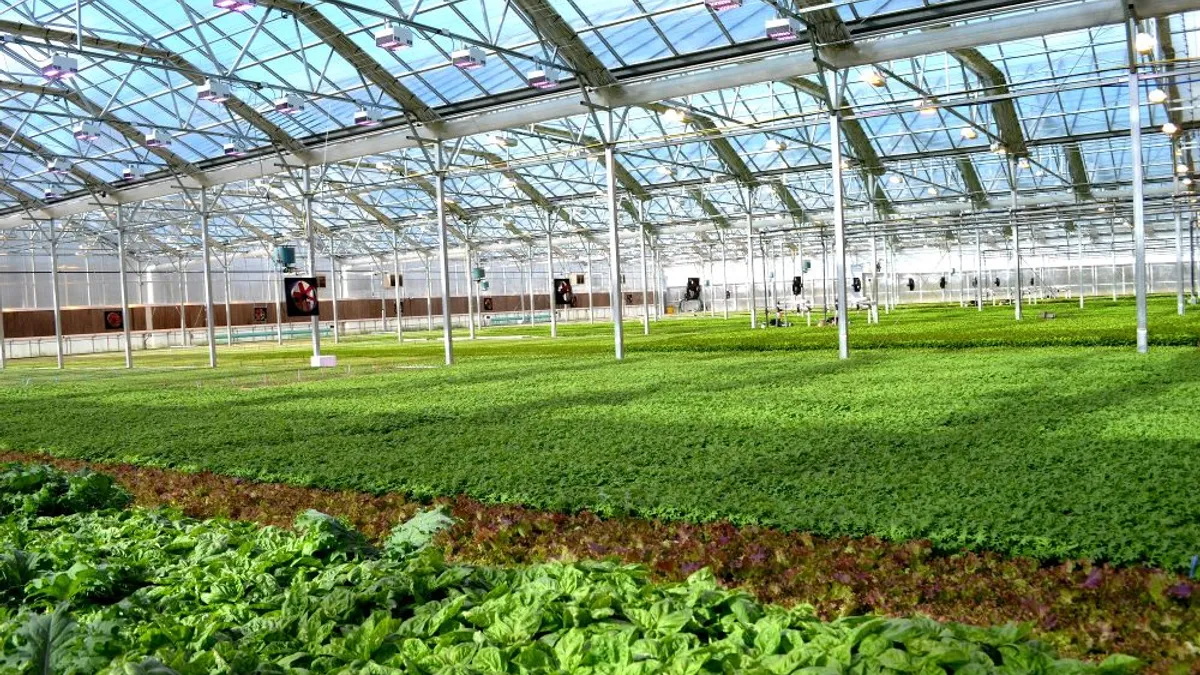Dive Brief:
- Packaged salad company BrightFarms is expanding its retail footprint in the four regions where it currently operates hydroponic greenhouses to supply consumers with year-round local produce. The company is in a five-year growth phase as it attempts to scale up its local produce model.
- BrightFarms’ products will now be available at Jungle Jim’s International Markets in Ohio and Food Lion Stores at some of its Virginia locations. BrightFarms is entering the St. Louis metro in Dierbergs Markets, which will carry its line of greens that feature lettuce varieties like Sunny Crunch and Fresh Kick. It will also supply over 140 Tops Friendly Markets stores throughout New York, Pennsylvania, and Vermont. BrightFarms greenhouses are located in Rochelle, Ill.; Culpeper County, Va.; Bucks County, Pa. and Wilmington, Ohio.
- BrightFarms is also partnering with food waste fighting startup Misfits Market, a delivery box service that ships imperfect or “ugly” produce to customers in Pennsylvania, New Jersey, and Delaware. BrightFarms will supply excess yields from its Bucks County, Pennsylvania, greenhouse.
Dive Insight:
Locally grown food has graduated from a hot trend to a well-established segment of the market, with the U.S. Department of Agriculture estimating $20 billion in sales for 2019. Consumers choose locally grown products for a variety of reasons such as reducing food miles, supporting local farmers and for what they see as a better quality product.
By its very nature, however, building a successful business off a locally grown model makes scaling a challenge. Add logistics into the mix – which has been the death knell of several meal kit startups – and one can quickly see why a local food company has yet to truly achieve nationwide reach.
BrightFarms is hoping to break through these barriers using a few strategic business tactics. The company seeks out partnerships with supermarkets, municipalities and vendors to streamline the distance and costs it incurs in getting its produce to market. In return, major retailers get to offer consumers locally grown produce at the same store where they shop for other household staples, saving them a trip to the farmers market and helping the store compete with dedicated natural food grocers. Meanwhile, BrightFarms gets ready-made market access, advertising and brand recognition.
For sustainability-minded consumers, BrightFarms hydroponic greenhouses use 80% less water, 90% less land and 90% less fuel when compared to long distance growers, according to the company. All of its salad greens are also pesticide free and are certified non-GMO.
The last piece of the puzzle involves locating its tech-powered greenhouses close to city centers to enable produce deliveries within 24 hours of harvest, reducing transit time and transportation costs. Traditional produce sourcing requires five-to-seven days of transit time across thousands of miles, by BrightFarms’ account. The bells and whistles come at a cost, however. The New York-based company announced that it would build a 180,000 square-foot hydroponic greenhouse facility in Abilene, Texas, costing an estimated $17 million.
The opening date for that facility, originally slated for early this year, has been pushed back, according to a company spokeswoman. BrightFarms does plan to open other greenhouses this year, with location announcements coming soon, she said.
BrightFarms may be onto something when it comes to scaling local food, but it’s got at least two major competitors also chomping at the bit. Bay Area-based Plenty operates a vertical growing space to produce leafy greens and boasts $226 million in venture capital, while New-jersey based indoor ag operation AeroFarms has raked in $138 million.












